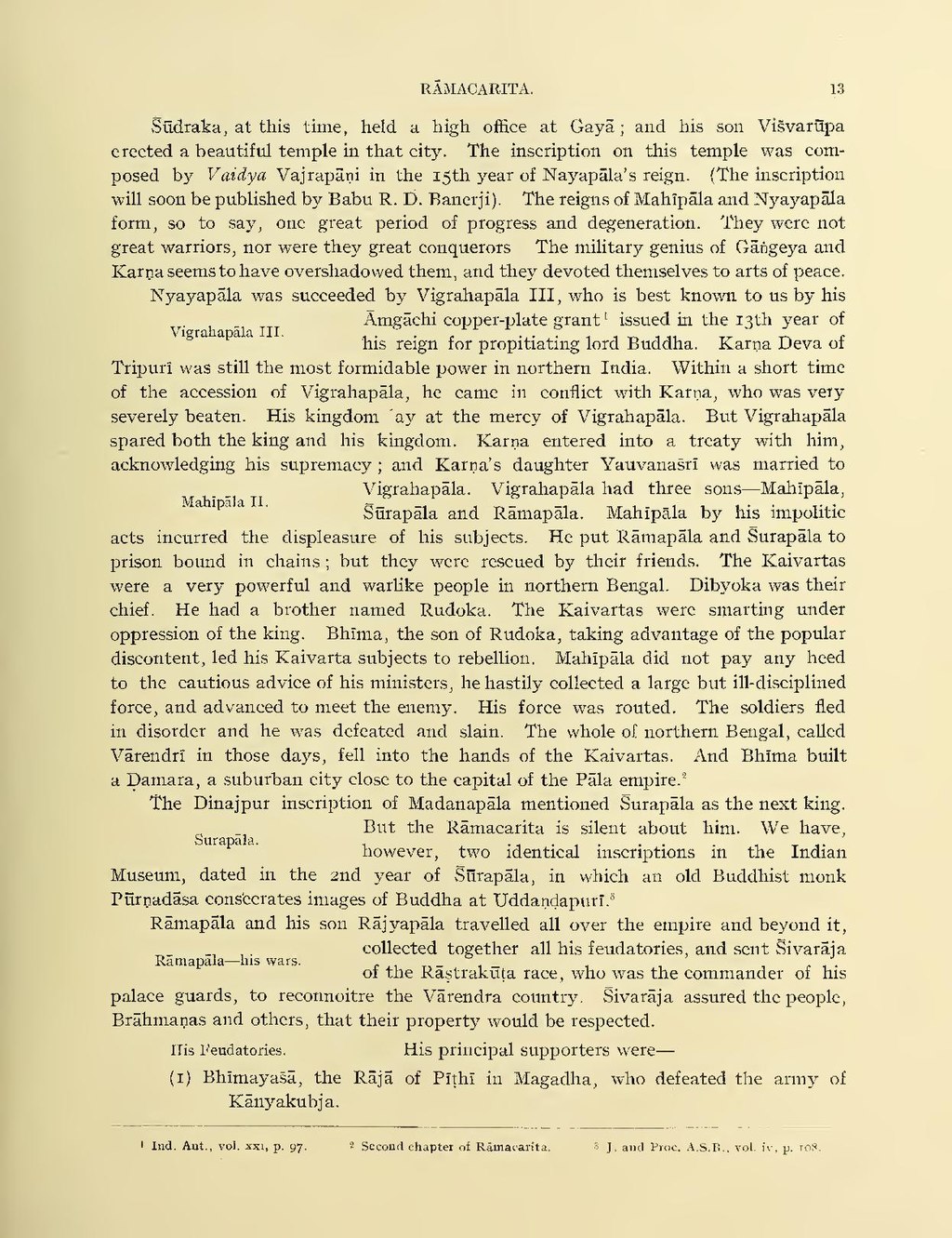RĀMACARITA. Sudraka, at this time, held a high office at Gaya; and his son Višvarūpa erected a beautiful temple in that city. The inscription on this temple was com- posed by Vaidya Vajrapāni in the 15th year of Nayapāla's reign. (The inscription will soon be published by Babu R. D. Banerji). The reigns of Mahipala and Nyayapāla form, so to say, one great period of progress and degeneration. They were not great warriors, nor were they great conquerors The military genius of Gängeya and Karna seems to have overshadowed them, and they devoted themselves to arts of peace. Nyayapala was succeeded by Vigrahapala III, who is best known to us by his Amgachi copper-plate grant issued in the 13th year of his reign for propitiating lord Buddha. Karna Deva of Vigrahapala III. Tripuri was still the most formidable power in northern India. Within a short time of the accession of Vigrahapala, he came in conflict with Karna, who was very severely beaten. His kingdom ay at the mercy of Vigrahapala. But Vigrahapāla spared both the king and his kingdom. Karna entered into a treaty with him, acknowledging his supremacy; and Karna's daughter Yauvanasri was married to Vigrahapāla. Vigrahapala had three sons-Mahipala, Surapala and Rāmapāla. Mahipala by his impolitic Mahipala II. acts incurred the displeasure of his subjects. He put Ramapala and Surapāla to prison bound in chains; but they were rescued by their friends. The Kaivartas were a very powerful and warlike people in northern Bengal. Dibyoka was their chief. He had a brother named Rudoka. The Kaivartas were smarting under oppression of the king. Bhima, the son of Rudoka, taking advantage of the popular discontent, led his Kaivarta subjects to rebellion. Mahipala did not pay any heed to the cautious advice of his ministers, he hastily collected a large but ill-disciplined force, and advanced to meet the enemy. His force was routed. The soldiers fled in disorder and he was defeated and slain. The whole of northern Bengal, called Varendri in those days, fell into the hands of the Kaivartas. And Bhima built a Damara, a suburban city close to the capital of the Pala empire.² Surapāla. The Dinajpur inscription of Madanapala mentioned Surapala as the next king. But the Ramacarita is silent about him. We have, however, two identical inscriptions in the Indian Museum, dated in the 2nd year of Surapala, in which an old Buddhist monk Purnadasa consecrates images of Buddha at Uddandapuri. Rāmapāla and his son Rajyapāla travelled all over the empire and beyond it, collected together all his feudatories, and sent Šivarāja Ramapala-his wars. of the Rāṣtrakūta race, who was the commander of his palace guards, to reconnoitre the Varendra country. Sivarāja assured the people, Brāhmaṇas and others, that their property would be respected. Ind. Aut., vol. xx1, p. 97. IIis l'eudatories. His principal supporters were- (1) Bhimayašā, the Raja of Pithi in Magadha, who defeated the army of Kanyakubja. 13 2 Second chapter of Ramacarita. J. and Proc. A.S.B., vol. iv, p. 108.

